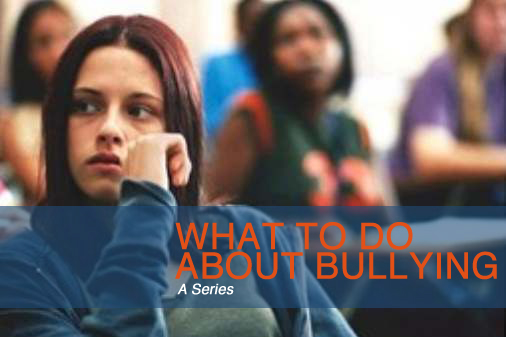Advice From 10 Experts On What To Do About Bullying
Advice From 10 Experts On What To Do About Bullying
There’s not much that breaks a parent’s heart faster than learning a son or daughter is being bullied. But often times, even adults feel under-equipped to intervene in school or to stop online harassment. Especially with new technology which can become a powerful tool in the hands of the bully.
Parents can feel helpless, which leads to frustration that can express itself in unhealthy ways like when a mom boarded a school bus and slapped the boy who was bullying her daughter.
For the last few weeks, we’ve been exploring what to do about bullying. Along these lines, the following experts study bullying, including how bullies use the internet to target others, and offer sound, practical advice on how to begin de-escalating the problem.
Read some of their advice excerpted below or click on their name to be taken to their
websites, which are also full of resources on what to do about bullying.
Joel Haber
“For generations, we’ve heard and passed on the same advice about how to deal with bullies—and yet, the bullying problem seems to be getting worse, not better. Maybe that’s because the advice doesn’t work? Ignore the bullies and they’ll go away.
Bullying is a normal rite of passage.
Just tell the teacher and it’ll stop.
The bully will stop picking on you if you learn how to fight.
These are the lines we’ve been fed—and maybe repeated ourselves. But the truth is that, as adults, we know deep down that some of these comments are absurd. What other kinds of problems are ever solved by ignoring them?

Dr.Michelle Borba
“Student bystanders may be our last, best hope in reducing bullying. Active student bystanders can:
~ Reduce the audience that a bully craves
~ Mobilize the compassion of witnesses to step in and stop the bullying
~ Support the victim and reduce the trauma
~ Be a positive influence in curbing a bullying episode
~ Encourage other students to support a school climate of caring
~ Report a bullying incident since 85 percent of time bullying occurs an adult is not present. Students are usually the witnesses.”

“Among the advice I thought was most counterproductive?
‘Ignore the bully.’ By the time a child reaches out to an adult, the vast majority of kids have been dealing with the bullying and trying to ignore it for a long time. The only thing that happens when you tell a kid to ignore the bully, is that they no longer think you care or are capable of helping them.”
“Adults can’t stop what they don’t see: On the bus, in the hallways, or just outside the school doors lies opportunity after opportunity for children to bully and to be victimized. Why? Because they are left on their own to police themselves. Some may argue that children must be able to, on the one hand, behave with character and on the other hand, defend themselves if that is not the case even when adults are not present. However, this simply isn’t happening for some students. To simply talk about what is supposed to happen as a solution to a problem that is happening is idiotic. Adults must be present in areas where children convene in and around the schools.”
“What adults forget about school is how exposing it is to learn something new and how humiliating it is to make mistakes in public. Stop and think. When was the last time you were required as part of your job, to do something inpublic that required mastering material you knew nothing about? When was the last time you your boss handed you back a report marked up in red ink? When was the last you got a grade on a piece of paper-in front of all your co-workers? Most adults avoid experiences like that. Children are put in embarrassing positions in school every day. It is so routine that we forget how painful it can be. This boy is smart enough to do the math; he needs to learn how to support himself emotionally when he does it. You can help.”

Rachel Simmons
“If you think a bully is some big dude in the schoolyard who steals people’s lunch money, you’ve only got part of the story. Truth is, girls often bully their friends. Crazy, right? But it’s true. Too many girls put up with terrible behavior from their friends because they keep calling them “friends.”
To promote safe online behavior, parents must familiarize themselves with the threats posed by the websites their children often visit. They should visit the sites themselves to learn about what their children are able to see and do, and then research the primary concerns associated with those sites. This information will enable parents to teach their children about the situations they will likely encounter and the appropriate responses.”
“Teach your children that no one has the right to violate their body. Model behaviors which you want them to imitate. Protect your child by making the school and other authorities accountable for the actions of their staffs. Demonstrate by doing; therefore have your child see you organize as a group in order to fight for a cause. Support your children when they sense danger or injustice. Discuss actions that they might do.”
“Indirect bullying, or more commonly ‘bystander bullying’ is when one child or a group of children intentionally ignore a bullying incident, exclude, or shun another child or group of children without ever having a physical altercation.
This type of bullying often has the same devastating effect as a physical assault.”

“The need to “be cool” is an emotional straightjacket. It keeps us from moving, growing, stretching and feeling free. “Cool” and
authentic are often mutually exclusive. It takes courage to be awkward, goofy, and silly – all of the feelings that we experience when we’re brave enough to try something new or risk being innovative. This is so tough for me. My mantra when I’m trying something
new and feeling awkward and goofy is “Effort + the courage to show up = enough.”
Brene Brown
See advice from these leading experts here or follow these links to resources for what to do about bullying, websites about bullying and quotes on bullying.








10 Expert Authors on What To Do About Bullying November 3, 2012 (7:07 pm)
[…] complex and multi-dimensional thanks to modern day technology. But fortunately, there are still people and organizations who devote themselves to stopping harassment and resourcing those being […]
64722 August 21, 2013 (12:17 am)
Hey there, I found your site sarahcunningham.org while browsing http://www.sarahcunningham.org/advice-from-experts-what-to-do-about-bullying. Have you ever thought of making use of slightly
more than only text in your articles? Don’t get me wrong, your writing is excellent. However, I think that if you integrated some other forms of media (such as videos, visuals, pictures) you could make your posts more substantive and alluring. Your content is superior, but if you add more varied media, your blog could without a doubt be top-of-the-line in its niche in comparison to other sites on .
?????? August 30, 2014 (4:50 pm)
Hey this is kind of of off topic but I was wondering if blogs use WYSIWYG editors or if you have to manually code with HTML. I’m starting a blog soon but have no coding experience so I wanted to get advice from someone with experience. Any help would be greatly appreciated!